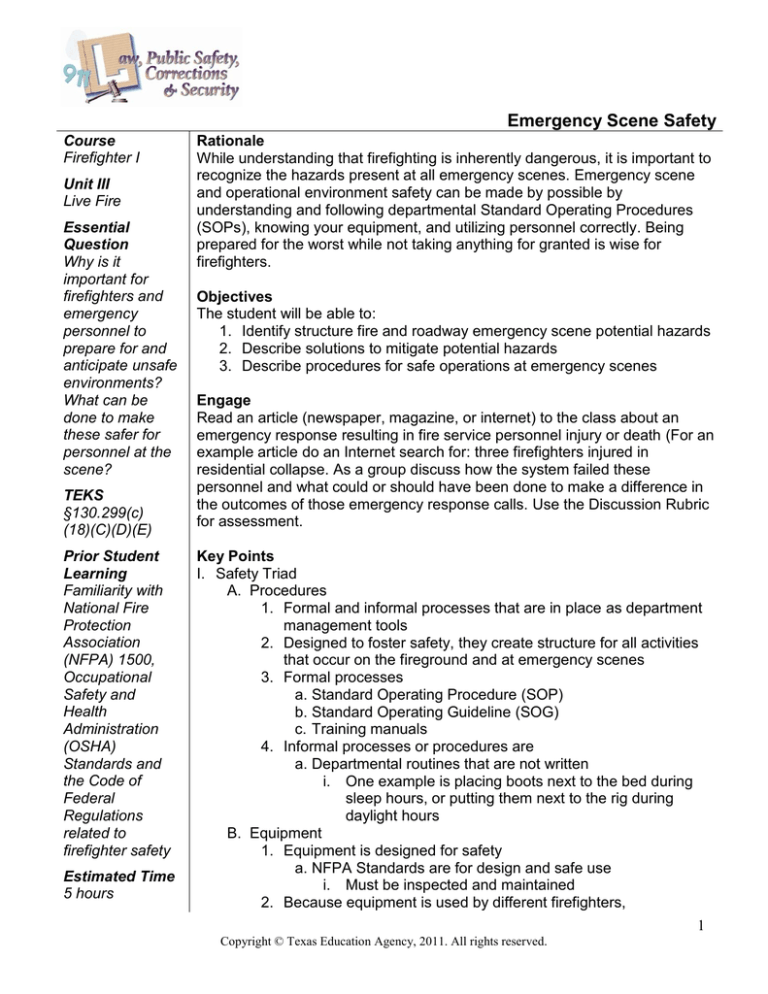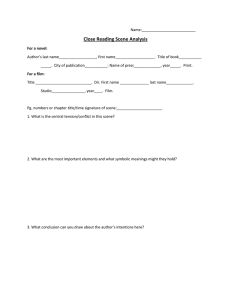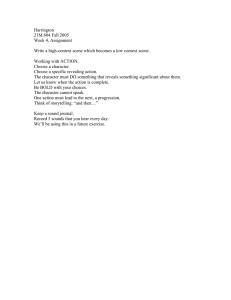Emergency Scene Safety
advertisement

Emergency Scene Safety Course Firefighter I Unit III Live Fire Essential Question Why is it important for firefighters and emergency personnel to prepare for and anticipate unsafe environments? What can be done to make these safer for personnel at the scene? TEKS §130.299(c) (18)(C)(D)(E) Prior Student Learning Familiarity with National Fire Protection Association (NFPA) 1500, Occupational Safety and Health Administration (OSHA) Standards and the Code of Federal Regulations related to firefighter safety Estimated Time 5 hours Rationale While understanding that firefighting is inherently dangerous, it is important to recognize the hazards present at all emergency scenes. Emergency scene and operational environment safety can be made by possible by understanding and following departmental Standard Operating Procedures (SOPs), knowing your equipment, and utilizing personnel correctly. Being prepared for the worst while not taking anything for granted is wise for firefighters. Objectives The student will be able to: 1. Identify structure fire and roadway emergency scene potential hazards 2. Describe solutions to mitigate potential hazards 3. Describe procedures for safe operations at emergency scenes Engage Read an article (newspaper, magazine, or internet) to the class about an emergency response resulting in fire service personnel injury or death (For an example article do an Internet search for: three firefighters injured in residential collapse. As a group discuss how the system failed these personnel and what could or should have been done to make a difference in the outcomes of those emergency response calls. Use the Discussion Rubric for assessment. Key Points I. Safety Triad A. Procedures 1. Formal and informal processes that are in place as department management tools 2. Designed to foster safety, they create structure for all activities that occur on the fireground and at emergency scenes 3. Formal processes a. Standard Operating Procedure (SOP) b. Standard Operating Guideline (SOG) c. Training manuals 4. Informal processes or procedures are a. Departmental routines that are not written i. One example is placing boots next to the bed during sleep hours, or putting them next to the rig during daylight hours B. Equipment 1. Equipment is designed for safety a. NFPA Standards are for design and safe use i. Must be inspected and maintained 2. Because equipment is used by different firefighters, 1 Copyright © Texas Education Agency, 2011. All rights reserved. documentation of repairs and maintenance is critical for personnel safety 3. Equipment use a. Using the right tool for the right job is essential for emergency scene safety b. For safety reasons, all equipment should be used in accordance with manufacturer’s specifications and directions C. Personnel 1. Human factors can contribute to scene safety a. Training needs to be regular and consistent b. Perhaps the single most important element of scene safety is training. It leads to good decisions and effective critical thinking skills 2. Firefighter fitness and health a. Enable firefighters to deal with the inherent stresses of firefighting i. Participate in annual health screenings ii. Work hardening to perform physical tasks (work hardening helps prevent firefighter injuries from typical firefighting tasks) b. Work hardening and mandatory fitness training and testing c. Nutrition education for fire service personnel relates directly to incident readiness and scene safety d. Critical Incident Stress Management (CISM) i. A system used for firefighters and others who work with fire victims to help them to cope with or resolve the stress of working with gruesome injuries and/or horrific scenes ii. Prebriefing (knowing what to expect) can ease the stress of entering a scene iii. Defusing (minor debriefing after an event) can ease stress for firefighters who must enter a scene more than once iv. Qualified stress managers should be available when needed v. Personnel should utilize Member Assistance Programs (MAP) vi. Deals with issues that could affect job performance and firefighter safety vii. Offers professional, mental health services and other health services to fire service employees II. Assigned Responsibility for Scene Safety A. Department (effective leadership) 1. Enforce departmental rules, policies, and procedures in accordance with NFPA 1500 (Standard on Fire Department Occupational Safety and Health Program) and OSHA regulations 2 Copyright © Texas Education Agency, 2011. All rights reserved. (which are part of the Code of Federal Regulations) Create a health and safety committee Develop SOPs relative to safety Implement a risk management plan Purchase appropriately safe and effective apparatus and equipment 6. All training should occur with an emphasis on safety B. Firefighter (operational readiness) 1. Prepared mentally 2. Prepared physically 3. Understand operational procedures a. Recognizes and follows the Chain of Command. b. Performance is consistent with training expectations 2. 3. 4. 5. III. Hazard Recognition for Fire and Roadway Emergencies A. Highway (roadway) emergencies 1. Follow Department of Transportation (DOT) guidelines a. Position apparatus to block oncoming traffic i. Block at least one traffic lane next to the incident (more if necessary) ii. Be extremely careful when dismounting the apparatus b. Turn the front wheels in the direction away from the emergency c. Use traffic cones effectively to detour traffic away from the scene d. Turn off the lights facing oncoming traffic to avoid distracting or blinding drivers e. Do not walk with your back to traffic f. Wear reflective vests if not using Personal Protective Equipment (PPE) B. Fire and other emergencies 1. Crowd control a. To maintain a scene safety b. To prevent interference with firefighters and other emergency personnel operating at emergency incidents c. To prevent injuries to spectators and emergency response teams d. Relatives and friends of victims in an incident should be restrained from coming too close to emergency operations (do not leave them unattended; have someone attend to them until the victims are removed from the scene) 2. Scene control zones a. Can be used to establish scene security i. Many departments establish three zones a) Hot b) Warm c) Cold 3 Copyright © Texas Education Agency, 2011. All rights reserved. 3. Personnel accountability a. Used to identify and track personnel at emergency incidents i. Passport systems (tag systems) account for personnel within the hazard zone ii. Passports are collected by an accountability officer and attached to a control board or an ID chart. They are returned as personnel leave the hazard zone 4. Self-Contained Breathing Apparatus (SCBA) Tag System a. More accountability than a passport system i. In addition to passport collection, time of entry is noted along with lowest SCBA pressure among team members ii. PPE is checked prior to entry 5. Interior operations a. Follow the department’s SOPs b. Size up before making interior entry (look for windows or doors that could be used as emergency exits) c. Wear full PPE (including SCBA) always d. Have tools with you as necessary e. Stay in contact with your team through physical, voice, or visual contact f. Maintain radio contact with the Incident Commander (IC) g. Take some sort of tag line, lifeline, or hose with you into the hazard zone h. Be aware of your surroundings by maintaining situational awareness i. Know when and how to call for help (use “Mayday,” the international distress signal) 6. Emergency escape a. Be prepared to save yourself b. Understand how to activate your Personal Alert Safety System (PASS) device 7. Rapid Intervention Teams/Crews (RIT/RIC) a. Part of the 2-in/2-out criteria mandated by NFPA 1500 and OSHA anytime firefighters are going to be in an atmosphere that is Immediately Dangerous to Life or Health (IDLH) b. The primary assignment is to rescue emergency personnel who have become lost, disorientated, injured, or trapped Activities 1. Have students identify and list potential roadway and emergency scene hazards. Then have them describe procedures and solutions to mitigate those hazards for fire service safe operations at emergencies. Use the Writing Rubric for assessment. 2. Have students write a scenario about a structure fire incident and then have them trade scenarios (alternative: The instructor may want to create a scenario instead). Each student will have five minutes to 4 Copyright © Texas Education Agency, 2011. All rights reserved. explain and demonstrate the elements of a Personnel Accountability System used by the local jurisdiction. Use the Recognizing the Elements of a SCBA Tag System Checklist for assessment. Assessments Emergency Scene Safety Quiz and Key Recognizing the Elements of a SCBA Tag System Checklist Discussion Rubric Writing Rubric Materials Emergency Scene Safety computer-based presentation Status board Personnel Accountability Tags Resources 0135151112, Essentials of Firefighting (5th Edition), International Fire Service Training Association (IFSTA) 9781428339828, Firefighter's Handbook: Firefighter I and Firefighter II (3rd Edition), Delmar Cengage Learning Do an Internet search for: three firefighters injured in residential collapse Accommodations for Learning Differences For reinforcement, students will participate in peer teaching (mentoring) and team learning; participate in guided research and note-taking (web based); and keep journals with key words and definitions. For enrichment, students will participate in situational awareness exercises and classroom discussion and training exercises. State Education Standards Texas Essential Knowledge and Skills for Career and Technical Education §130.299. Firefighter I (One to Two Credits). (18) The student identifies safety procedures for ensuring a safe environment. The student is expected to: (C) identify structure fire and roadway emergency scene potential hazards; (D) describe solutions to mitigate potential hazards; and (E) describe procedures for safe operation at emergency scenes. College and Career Readiness Standards English/Language Arts II. Reading B Understand new vocabulary and concepts and use them accurately in reading, writing and speaking. 1. Identify new words and concepts acquired through study of 5 Copyright © Texas Education Agency, 2011. All rights reserved. their relationships to other words and concepts. 6 Copyright © Texas Education Agency, 2011. All rights reserved. Name________________________________ Date__________________________ Emergency Scene Safety Quiz 1. _____ Which of the following is not one of the three components of the Safety Triad? a. Procedures b. Personnel c. Equipment d. Training 2. _____ Department rules, policies, and procedures should be aligned and in accordance with a. NFPA 1500 b. OSHA (Code of Federal Regulations) c. Both a and b d. Neither a or b 3. _____ Informal procedures should be documented in writing before they can be considered a departmental routine. a. True b. False 4. _____ Which of the following offer(s) professional mental health services and other health services to fire service employees? a. Medical Assistance Programs (MAP) b. Critical Incident Stress Debriefings c. Risk Management Programs d. All of the above 5. _____ Which of the following is considered to be a formal process or procedure? a. Standard Operating Procedure (SOP) b. Standard Operating Guidelines (SOG) c. Training Manuals d. All of the above 6. _____ During highway/roadway emergencies, emergency personnel should block at least _____ next to the incident. a. Two traffic lanes or more if necessary b. One traffic lane or more if necessary c. One traffic lane or more if necessary in each direction. d. None of the above 7 Copyright © Texas Education Agency, 2011. All rights reserved. 7. _____ Many fire departments establish _____ scene control zones to establish scene security. a. 1 b. 2 c. 3 d. 4 8. _____ Self-Contained Breathing Apparatus (SCBA) Tag Systems offer more accountability than a passport system. a. True b. False 9. _____ During interior operations, emergency services personnel should a. Follow department SOPs b. Always carry the necessary tools c. Maintain situational awareness d. All of the above 10. _____ A Rapid Intervention Team’s primary assignment is a. To stand by if needed to replace already deployed teams b. Rescue trapped victims in an emergency such as a fire or building collapse c. To rescue emergency personnel who have become lost, trapped, disoriented, or injured d. All of the above 8 Copyright © Texas Education Agency, 2011. All rights reserved. Emergency Scene Safety Quiz Key 1. 2. 3. 4. 5. 6. 7. 8. 9. 10. D C B A D B C A D C 9 Copyright © Texas Education Agency, 2011. All rights reserved. Name: _________________________ Date: __________________________ Recognizing the Elements of a SCBA Tag System Checklist Directions: Using the scenario, verbally explain and demonstrate the elements of a Personnel Accountability System used by the local jurisdiction. You will have five (5) minutes to complete this task. The task (skill) will end when you state to me that you have completed all of the identified steps. Do you understand these instructions? Equipment needed: Status board Personnel Accountability Tags Performance Objectives Pts. Verbally identify components of the Personnel Accountability System Status Board (1 pt.) Tag System (1 pt.) SCBA Tag System (1 pt.) State who is responsible for implementation (2 pts.) Show how the status board accounts for personnel (2 pts.) States that all personnel leaving and entering an emergency scene must/will notify the designated accountability officer (1 pt.) Deduct points only for the following: Student takes longer than 3 minutes but less than 4 minutes (1 pt. deduction) Student takes longer than 4 minutes but less than 5 minutes (2 pts. deduction) Student takes 5 minutes or longer (3 pts. deduction) Total points possible – 8 Instructor’s Signature Date 10 Copyright © Texas Education Agency, 2011. All rights reserved. Name_______________________________________ Date_______________________________ Discussion Rubric Objectives 4 pts. Excellent 3 pts. Good 2 pts. Needs Some Improvement 1 pt. Needs Much Improvement N/A Pts. Participates in group discussion Encourages others to join the conversation Keeps the discussion progressing to achieve goals Shares thoughts actively while offering helpful recommendations to others Gives credit to others for their ideas Respects the opinions of others Involves others by asking questions or requesting input Expresses thoughts and ideas clearly and effectively Total Points (32 pts.) Comments: 11 Copyright © Texas Education Agency, 2011. All rights reserved. Name:____________________________________ Date:_____________________________ Writing Rubric 4 pts. Excellent Objectives 3 pts. Good 2 pts. Needs Some Improvement 1 pt. Needs Much Improvement N/A Pts. The writing has all required parts from introduction to conclusion in smooth transition. The writing is interesting, supportive, and complete. The writing demonstrates that the writer comprehends the writing process. Accurate spelling, grammar, and punctuation The content of paragraphs emphasizes appropriate points. The writer shows an understanding of sentence structure, paragraphing, and punctuation. All sources and references are clearly and accurately documented. Total Points (28 pts.) Comments: 12 Copyright © Texas Education Agency, 2011. All rights reserved.




